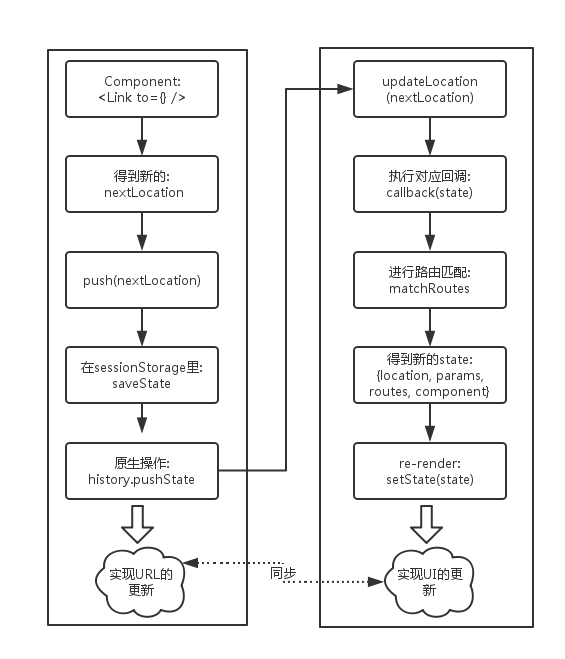react-router的实现原理
目前, react 的生态越来越丰富,像 flux redux react-router 已经被越来越多的使用,本文就 react-router 的内部实现进行分析。文章主要包含两大部分: 一是对 react-router 赖以依存的 history 进行研究;二是分析 react-router 是如何实现 URL 与 UI 同步的。
1. react-router的依赖基础 - history
1.1 History的整体介绍
history 是一个独立的第三方js库,可以用来兼容在不同浏览器、不同环境下对历史记录的管理,拥有统一的API。具体来说里面的history分为三类:
- 老浏览器的history: 主要通过hash来实现,对应
createHashHistory - 高版本浏览器: 通过html5里面的history,对应
createBrowserHistory - node环境下: 主要存储在memeory里面,对应
createMemoryHistory
上面针对不同的环境提供了三个API,但是三个API有一些共性的操作,将其抽象了一个公共的文件 createHistory :
// 内部的抽象实现 function createHistory(options={}) { ... return { listenBefore, // 内部的hook机制,可以在location发生变化前执行某些行为,AOP的实现 listen, // location发生改变时触发回调 transitionTo, // 执行location的改变 push, // 改变location replace, go, goBack, goForward, createKey, // 创建location的key,用于唯一标示该location,是随机生成的 createPath, createHref, createLocation, // 创建location } } 上述这些方式是history内部最基础的方法, createHashHistory 、 createBrowserHistory 、 createMemoryHistory 只是覆盖其中的某些方法而已。其中需要注意的是,此时的location跟浏览器原生的location是不相同的,最大的区别就在于里面多了 key 字段, history 内部通过 key 来进行 location 的操作。
function createLocation() { return { pathname, // url的基本路径 search, // 查询字段 hash, // url中的hash值 state, // url对应的state字段 action, // 分为 push、replace、pop三种 key // 生成方法为: Math.random().toString(36).substr(2, length) } } 1.2 内部解析
三个API的大致的技术实现如下:
-
createBrowserHistory: 利用HTML5里面的history -
createHashHistory: 通过hash来存储在不同状态下的history信息 -
createMemoryHistory: 在内存中进行历史记录的存储
1.2.1 执行URL前进
-
createBrowserHistory: pushState、replaceState -
createHashHistory:location.hash=***location.replace() -
createMemoryHistory: 在内存中进行历史记录的存储
伪代码实现如下:
// createBrowserHistory(HTML5)中的前进实现 function finishTransition(location) { ... const historyState = { key }; ... if (location.action === 'PUSH') ) { window.history.pushState(historyState, null, path); } else { window.history.replaceState(historyState, null, path) } } // createHashHistory的内部实现 function finishTransition(location) { ... if (location.action === 'PUSH') ) { window.location.hash = path; } else { window.location.replace( window.location.pathname + window.location.search + '#' + path ); } } // createMemoryHistory的内部实现 entries = []; function finishTransition(location) { ... switch (location.action) { case 'PUSH': entries.push(location); break; case 'REPLACE': entries[current] = location; break; } } 1.2.2 检测URL回退
-
createBrowserHistory:popstate -
createHashHistory:hashchange -
createMemoryHistory: 因为是在内存中操作,跟浏览器没有关系,不涉及UI层面的事情,所以可以直接进行历史信息的回退
伪代码实现如下:
// createBrowserHistory(HTML5)中的后退检测 function startPopStateListener({ transitionTo }) { function popStateListener(event) { ... transitionTo( getCurrentLocation(event.state) ); } addEventListener(window, 'popstate', popStateListener); ... } // createHashHistory的后退检测 function startPopStateListener({ transitionTo }) { function hashChangeListener(event) { ... transitionTo( getCurrentLocation(event.state) ); } addEventListener(window, 'hashchange', hashChangeListener); ... } // createMemoryHistory的内部实现 function go(n) { if (n) { ... current += n; const currentLocation = getCurrentLocation(); // change action to POP history.transitionTo({ ...currentLocation, action: POP }); } } 1.2.3 state的存储
为了维护state的状态,将其存储在sessionStorage里面:
// createBrowserHistory/createHashHistory中state的存储 function saveState(key, state) { ... window.sessionStorage.setItem(createKey(key), JSON.stringify(state)); } function readState(key) { ... json = window.sessionStorage.getItem(createKey(key)); return JSON.parse(json); } // createMemoryHistory仅仅在内存中,所以操作比较简单 const storage = createStateStorage(entries); // storage = {entry.key: entry.state} function saveState(key, state) { storage[key] = state } function readState(key) { return storage[key] } 2. react-router的基本原理
一句话:实现URL与UI界面的同步。其中在react-router中, URL 对应 Location 对象,而UI是由react components 来决定的,这样就转变成 location 与 components 之间的同步问题。

3. react-router的具体实现
react-router在 history 库的基础上,实现了URL与UI的同步,分为两个层次来描述具体的实现。
3.1 组件层面描述具体实现过程
在 react-router 中最主要的 component 是 Router RouterContext Link , history 库起到了中间桥梁的作用。

3.2 API层面描述具体实现过程
为了简单说明,只描述使用browserHistory的实现,hashHistory的实现过程是类似的,就不在说明。

4. 结语
目前 react-router 在项目中已有大量实践,其优点可以总结如下:
- 风格: 与React融为一体,专为react量身打造,编码风格与react保持一致,例如路由的配置可以通过component来实现
- 简单: 不需要手工维护路由state,使代码变得简单
- 强大: 强大的路由管理机制,体现在如下方面
- 路由配置: 可以通过组件、配置对象来进行路由的配置
- 路由切换: 可以通过
<Link>Redirect进行路由的切换 - 路由加载: 可以同步记载,也可以异步加载,这样就可以实现按需加载
- 使用方式: 不仅可以在浏览器端的使用,而且可以在服务器端的使用
当然 react-router 的缺点就是API不太稳定,在升级版本的时候需要进行代码变动。











![[HBLOG]公众号](http://www.liuhaihua.cn/img/qrcode_gzh.jpg)

